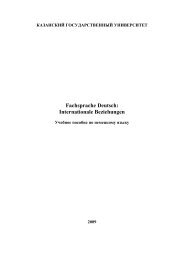Essential Journalism and Media Writing - It works - ÐазанÑкий ...
Essential Journalism and Media Writing - It works - ÐазанÑкий ...
Essential Journalism and Media Writing - It works - ÐазанÑкий ...
Create successful ePaper yourself
Turn your PDF publications into a flip-book with our unique Google optimized e-Paper software.
After working at a string of unsuccessful jobs in St. Louis, Pulitzer became interested injournalism <strong>and</strong> realized he had found his calling. In 1878, he bought the St. Louis Post-Dispatch <strong>and</strong> quickly turned it into a success. Just five years later, he was ready to try his h<strong>and</strong>in the high-stakes world of New York City journalism. The New York World, a paper infinancial trouble, was for sale. Pulitzer bought it. In a little more than a year, circulationincreased from 15,000 to 100,000. Two years later it topped the quarter-million mark.Pulitzer had obviously found a formula for newspaper success, <strong>and</strong> his innovations areworth considering. First, Pulitzer introduced new practices that appealed to advertisers: Hereserved more space for ads <strong>and</strong> sold his paper on the basis of circulation. Second, Pulitzerused illustrations, clean page makeup, <strong>and</strong> simple writing to extend his paper's appeal toimmigrants with few skills in English. Third, the World never failed to promote itself in itsown pages. Circulation figures were printed on the front page. Stunts were used to promotecirculation. Pulitzer sent reporter Nelly Bly on a round-the-world trip to break the timementioned in Jules Verne's Around the World in 80 Days. Ms. Bly spent a night in a hauntedhouse, went down in a diving bell, <strong>and</strong> worked in the Salvation Army. Her stories on theseexperiences helped Pulitzer build readership. Fourth, Pulitzer attracted a mass readership byreintroducing the sensationalized news of the penny-press era into his paper. In his first issue,Pulitzer led with a report of a storm that devastated New Jersey <strong>and</strong> included on his front pagean interview with a condemned slayer, an item about a hanging, <strong>and</strong> a tearjerker about awronged servant girl. Pulitzer loved headlines with alliteration. If alliteration could be mixedwith sex, crime, <strong>and</strong> violence, so much the better, as these examples indicate: "Little Lotta'sLovers," "Baptized in Blood," "Jim-Jams in the Jury," <strong>and</strong> "A Preacher's Perfidy." Finally,Pulitzer endorsed the notion that a newspaper should promote the general welfare of itsreaders, especially the underprivileged. Although Pulitzer did not originate the idea, he went togreat lengths to put it into practice. The paper crusaded against the abuses of big business <strong>and</strong>corrupt politicians. In 1833, a heat wave caused many infant deaths in New York'sovercrowded slums. The World quickly produced headlines: "How Babies Are Baked," "LittleLines of Hearses." (Alliteration was also mixed in with crusades.) Naturally, the World'ssupport of the working class made it a favorite among the many low-income immigrants thenliving in New York.Hearst, like Pulitzer before him, then invaded the big league-New York City. In 1895, hebought the New York Journal. Soon, Pulitzer <strong>and</strong> Hearst were engaged in a fierce circulationbattle as each paper attempted to out-sensationalize the other. As one press critic put it, the duelbetween these two spread "death, dishonor <strong>and</strong> disaster" all over page one. Sex, murder,popularized medicine; pseudoscience, self-promotion, <strong>and</strong> human-interest stories filled the twopapers. This type of reporting became known as yellow journalism (named after a cartooncharacter, the Yellow Kid, who wore a bright yellow nightshirt), <strong>and</strong> whatever its faults, it soldnewspapers.The battle between Pulitzer <strong>and</strong> Hearst reached its climax with the Spanish- AmericanWar in 1898. In fact, many historians have argued that the newspapers were an importantfactor in shaping public opinion in favor of hostilities. When the battleship Maine was blownup in Havana Harbor, the Journal offered a $50,000 reward for the arrest of the guilty parties.Circulation jumped over the million marks. War was finally declared in April, <strong>and</strong> the World<strong>and</strong> the Journal pulled out all the stops. Hearst chartered a steamer <strong>and</strong> equipped it withprinting presses. He also brought down his yacht <strong>and</strong> sailed with the U.S. fleet in the battle ofSantiago. The Journal put out forty extras in a single day.48





